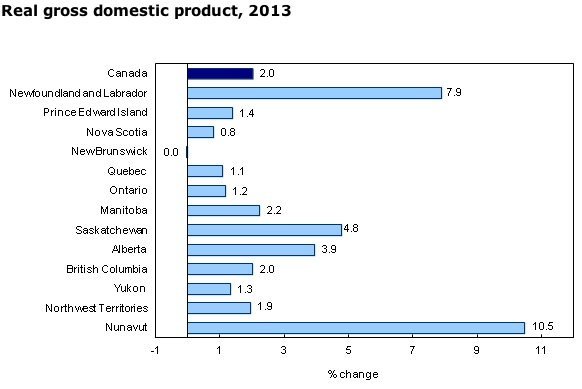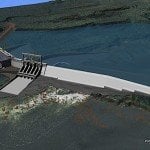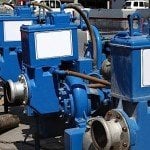Canada’s economic output grew 2 per cent in 2013, with growth in every province but New Brunswick. The greatest growth was seen in Newfoundland and Labrador where GDP was up 7.9 per cent, and in Nunavut, with 10.5 per cent. Several other provinces experienced growth above the national average, while Ontario and Quebec fell below it, Statistics Canada reports.
The Newfoundland and Labrador growth was the result of “significantly higher” engineering construction, and a rebound in mining, quarrying, and oil and gas extraction. Public service industries such as health care and education, and the manufacturing sector, saw output decline, however.
The exceptional growth in Nunavut was the result of increases in construction, mining, quarrying, and oil and gas extraction. The latter saw growth of 16 per cent. Most public sector industries also increased.

Ontario’s GDP advanced 1.2 per cent in 2013, down from the 1.4 per cent increase in 2012. Goods production fell 1.5 per cent in the province, with decreases in construction and manufacturing outweighing increases in mining and electric power generation and distribution. The decline in construction affected both residential and non-residential buildings, as well as engineering construction, dropping 4 per cent in all. Manufacturing output was off by 2.3 per cent, with declines in computer and electronic products, cars and car parts, machinery, iron and steel.
Services output rose 2 per cent in Ontario, with increases in retail trade, finance and insurance, education, real estate, professional, scientific and technical services, and accommodation and food services. Higher output of local, municipal and regional public administration services was offset by a decline in federal government public administration and defence services.
In Quebec, GDP grew 1.1 per cent in 2013, with notable areas of strength in metal ore mining and electric power generation. Non-residential building construction rose 11 per cent.
Of the western provinces, Saskatchewan experienced the greatest GDP growth with a 4.8 per cent increase in 2013. Goods-producing industries increased their output 6.6 per cent and services industries grew 3 per cent. Crop production increased 38 per cent, the result of a bumper wheat crop and a record canola crop. Strong export demand led to higher output of non-metallic mineral mining (which includes potash) in the first half of the year. Manufacturing output increased 3.4 per cent, with gains in chemical, food and wood products. Wholesale trade and transportation services rose in parallel with increased production in goods producing industries.
Strong employment and population growth in Saskatchewan stimulated demand for retail trade, finance and insurance services, accommodation and food services and residential building construction, though engineering construction fell 7.1 per cent.
Alberta’s overall growth of 3.9 per cent coincided with a 3.9 per cent increase in oil and gas extraction. All but one of twenty major industry groups increased production, however, the greatest increase being in crop production, which was up 21 per cent. Construction was up 7 per cent, with strong growth in engineering projects and in residential building.
































